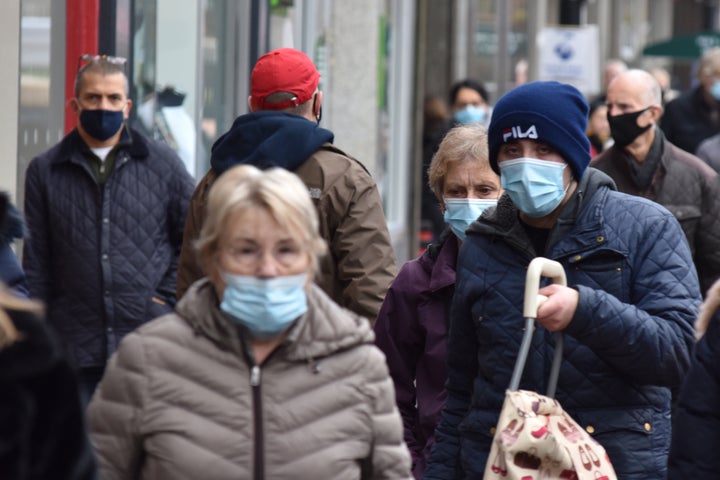
Fears that the ongoing effects of lockdowns could be causing higher excess death rates led The Telegraph’s front page on Friday – but that claim is not the full picture.
There are still excess deaths – data from the Office for National Statistics (ONS) found excess deaths are higher than the five-year average right now, meaning there were approximately 1,350 more deaths than expected during pre-pandemic years in the week ending August 5 across England and Wales.
Since June this year, the ONS found there have been nearly 10,000 more deaths than the five-year average (not including those linked to Covid). This is more than the number of people who died from Covid during the same time period.
The Telegraph claims this suggests the impact of the lockdowns is therefore still having an effect on UK health. The Department of Health also told the newspaper that many of these deaths were linked to preventable cardiovascular conditions, strokes and diabetes.
However, there are many factors at play here which need to be considered before blaming lockdown.
Don’t forget why we locked down
Lockdowns reduced Covid transmission. If lockdowns had not happened, then the NHS’ current backlog would have been much worse because the health service would have been trying to deal with a much higher number of Covid cases at the time.
The lockdowns in the UK also happened before the most of the population were able to access the Covid vaccination programme, which is now our primary defence against the virus and reduces the severity of its symptoms.
The vaccine is, essentially, what enabled the UK to leave lockdown.
Professor Chris Whitty, chief medical officer for England, was pressed on that same issue last December and said that the idea Covid was not the most important issue the NHS had to address during infection waves was an “inversion of reality”.
Lockdowns were also a while ago
The last UK lockdown was in 2021. The first stretched between March and June 2020; the second covered November of the same year; and the third – including the short-lived tiered system – started in December 2020 and continued until April 2021.
Social distancing measures were lifted altogether in July 2021, just over a year ago.
Excess death experienced now therefore seem far removed from the lockdowns. While there could still be an indirect impact, there are far more likely reasons behind the current number of excess deaths.
Other potential causes of excess deaths
Delays for treatment within the NHS
Ambulance services have been struggling immensely recently, leaving people waiting (for up to 15 hours in some cases) before being able to reach them.
Sometimes, patients can also arrive at the hospital but not be able to receive further treatment for even more time because there are no spare beds or medical staff to treat them, a problem the NHS was experiencing even before Covid.
Nearly 30,000 people waited more than 12 hours in England’s A&Es in July, a record-high, according to data from the NHS.
The Financial Times’ John Burn-Murdoch also compared the estimated excess deaths over the summer with A&E delays and found a potential link – longer A&E waits could be raising the rate of preventable deaths.
Missed or late diagnoses, caused by the NHS’ previous prioritisation of Covid patients and the demand for its services, will have contributed to the higher death rate too.
Staff shortages
This is a crisis impacting people across industries, with many people dropping out of work during the pandemic due to long-term sickness and taking early retirement, including in the health service.
Brexit also meant a wave of workers returned to the EU – the number of nurses registering with the NHS, for instance, fell substantially in 2017 from 8,800 to 3,500.
As ONS data shows, the UK employment rate is also still below pre-pandemic levels at 75.6%, with total actual weekly hours still significantly lower than before the first lockdown.
The number of job vacancies between March and May this year also rose to a new record of 1.3million.
Supply shortages
It’s worth noting that even before the pandemic and any lockdowns then NHS England chief executive Simon Stevens was calling for “more acute beds” – and blaming underfunding from the government for the health services’ struggles to meet demand.
Covid-related illnesses
As The Telegraph pointed out, many deaths were linked to preventable cardiovascular conditions and diabetes – just two of many illnesses which scientists believe could become more likely after catching Covid.
An article from the editors-in-chief of British Medical Journal (BMJ) also claimed that Covid is still having a huge impact on the healthcare system.
They added: “What the hospital admissions figures hide is a rising tide of people with long Covid, now at two million and likely to be a major burden on the health service and the nation’s productivity, for a generation.”
Not only does this mean previous Covid infections may have increased those who still need hospital treatment now, but it exacerbates staff shortage – in turn, making receiving healthcare from the NHS even harder.
